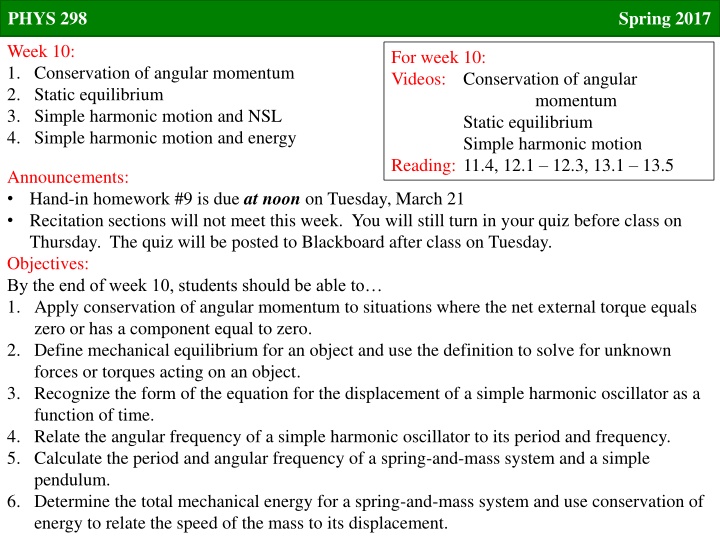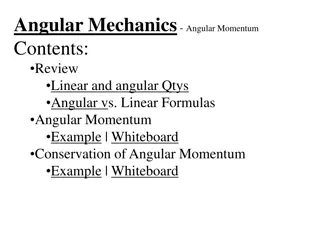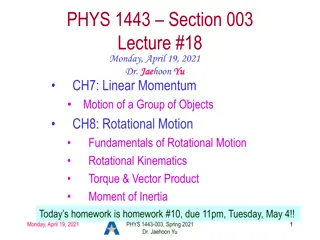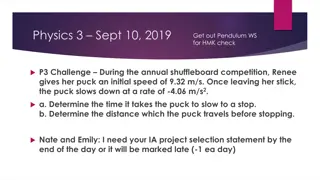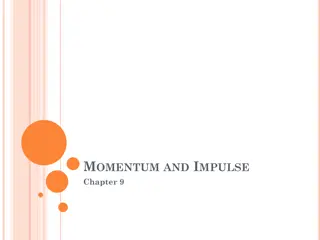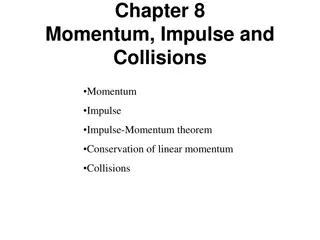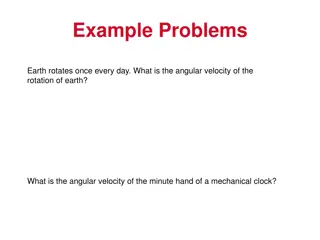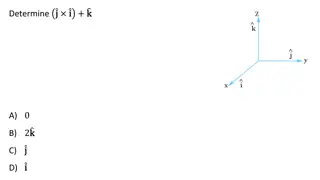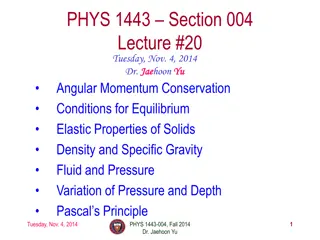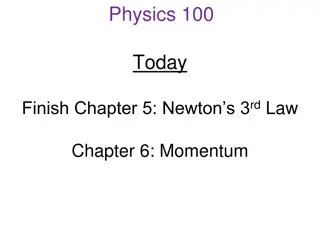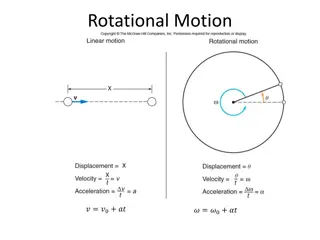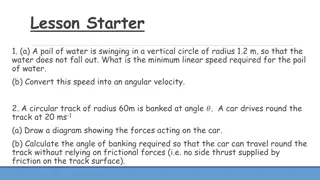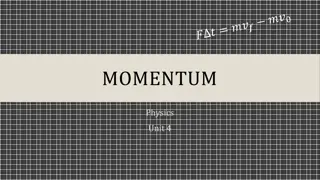Week 10: Conservation of Angular Momentum, Equilibrium, Harmonic Motion
In PHYS 298 Spring 2017 Week 10, students will explore topics such as conservation of angular momentum, static equilibrium, simple harmonic motion, and energy. The week's objectives include applying conservation of angular momentum, defining mechanical equilibrium, understanding simple harmonic oscillator displacement equations, calculating frequencies and periods, and analyzing mechanical energy in systems. Various examples and exercises are provided to enhance understanding of these concepts.
Download Presentation

Please find below an Image/Link to download the presentation.
The content on the website is provided AS IS for your information and personal use only. It may not be sold, licensed, or shared on other websites without obtaining consent from the author.If you encounter any issues during the download, it is possible that the publisher has removed the file from their server.
You are allowed to download the files provided on this website for personal or commercial use, subject to the condition that they are used lawfully. All files are the property of their respective owners.
The content on the website is provided AS IS for your information and personal use only. It may not be sold, licensed, or shared on other websites without obtaining consent from the author.
E N D
Presentation Transcript
PHYS 298 Spring 2017 Week 10: 1. Conservation of angular momentum 2. Static equilibrium 3. Simple harmonic motion and NSL 4. Simple harmonic motion and energy For week 10: Videos: Conservation of angular Static equilibrium Simple harmonic motion Reading: 11.4, 12.1 12.3, 13.1 13.5 momentum Announcements: Hand-in homework #9 is due at noon on Tuesday, March 21 Recitation sections will not meet this week. You will still turn in your quiz before class on Thursday. The quiz will be posted to Blackboard after class on Tuesday. Objectives: By the end of week 10, students should be able to 1. Apply conservation of angular momentum to situations where the net external torque equals zero or has a component equal to zero. 2. Define mechanical equilibrium for an object and use the definition to solve for unknown forces or torques acting on an object. 3. Recognize the form of the equation for the displacement of a simple harmonic oscillator as a function of time. 4. Relate the angular frequency of a simple harmonic oscillator to its period and frequency. 5. Calculate the period and angular frequency of a spring-and-mass system and a simple pendulum. 6. Determine the total mechanical energy for a spring-and-mass system and use conservation of energy to relate the speed of the mass to its displacement.
PHYS 298 Spring 2017 EX1: A 3.0-m-diameter merry-go-round with a rotational inertia of 10 kg m2 is spinning at a rate of 0.50 rev/s. A 25-kg child jumps on the edge of the merry-go-round. What is the new angular speed if the child ? (a) sits straight down (b) runs and jumps onto the merry-go-round with a speed of 3.0 m/s in the direction the merry-go-round is spinning (c) runs and jumps onto the merry-go-round with a speed of 3.0 m/s in the opposite direction as the one the merry-go- round is spinning
PHYS 298 Spring 2017 GW1: The figure below shows the overhead views of a series of uniform rods on which forces act perpendicularly to the rod. If the magnitudes of the forces are adjusted properly (but kept non-zero), which of the rods can be in static equilibrium? 2 3 1 5 6 4
PHYS 298 Spring 2017 EX2: A diver of weight 500 N stands at the end of a diving board of length L = 4 m and negligible mass. The board is fixed to two pedestals separated by distance d = 1.5 m. What are the magnitudes and directions of the forces exerted on the board by the two pedestals?
PHYS 298 Spring 2017 EX3: A uniform ladder of length L = 12 m and mass m = 15 kg leans against a frictionless wall at an angle of 30 with the wall. A firefighter of mass M = 72 kg climbs the ladder until he is at a point L/3 from the top of the ladder. What are the magnitudes of the forces on the ladder from the wall and ground?
PHYS 298 Spring 2017 EX4: A beam with a weight of 100 N is attached on one end to a wall with a hinge. The other end of the beam is connected to a cable that makes an angle of 60.0 with the beam as shown in the figure below. A sign with a weight of 150 N hangs from a cable that is attached to the beam at a point two-thirds of its length away from the wall. a. What is the tension in the cable? b. What is the magnitude and direction of the force exerted on the beam by the hinge?
PHYS 298 Spring 2017 GW2: A beam with a weight of 500 N is connected to the ground with a hinge. The beam makes an angle of = 60.0 with the ground and is held in place by a horizontal cable that is tied off to a wall. a. What is the tension in the cable? b. What is the magnitude and direction of the force exerted on the beam by the hinge?
PHYS 298 Spring 2017 Linear SHOs Angular SHOs x(t) = Acos(wt +j) vx(t) = -w Asin(wt +j) ax(t) = -w2Acos(wt +j) = -w2x(t) = + + ( ) cos( A ) t A t Equations of motion for SHM = + ( ) sin( ) t t = 2 ( ) cos( ) t A t = 2 ( ) t xmax= A vmax= A amax= 2A max= A max= A max= 2A Maximum values
PHYS 298 Spring 2017 w =2p For all SHOs: T For specific SHOs: Angular frequency Period Tsm=2p m k k m Spring-and-mass system = 2p wsm= wsm Tsp=2p l g g l Simple pendulum = 2p wsp= wsm Tpp=2p I mgh I Physical pendulum = 2p wpp= wpp mgh
PHYS 298 Spring 2017 Displacement Velocity Acceleration 5 4 3 2 1 t 0 -1 -2 -3 -4 -5
PHYS 298 Spring 2017 GW1: A mass is attached to a spring, pulled away from equilibrium, and then released at time t = 0 s. After it has been released, the mass undergoes simple harmonic motion. In terms of the period T of the motion of the mass, how long after t = 0 would you need to wait for the first two times for each of the following to occur? a. The speed of the mass is a maximum b. The mass returns to its original position c. The mass comes to a stop d. All of the energy of the mass is in kinetic energy e. All of the energy of the mass is in potential energy
PHYS 298 Spring 2017 GW2: A SHO oscillates back and forth on a frictionless surface with a maximum displacement from equilibrium of 30 cm. Over a complete period, where does the oscillator spend more time? 1. Less than 15 cm away from equilibrium 2. More than 15 cm away from equilibrium 3. It spends the same amount of time less than 15 cm away from equilibrium as it does more than 15 cm away
PHYS 298 Spring 2017 U(x) K(x) E(x) Energy (J) -0.05 0 0.05 position (m)
PHYS 298 Spring 2017 U(t) K(t) E(t) Energy (J) 0 2 4 time (s)
PHYS 298 Spring 2017 GW3: A SHO oscillates back and forth on a frictionless surface with a maximum displacement from equilibrium of 30 cm. At what position does the kinetic energy of the oscillator equal the potential energy stored in the spring? 1. Less than 15 cm away from equilibrium 2. Exactly 15 cm away from equilibrium 3. More than 15 cm away from equilibrium
PHYS 298 Spring 2017 EX1: A 0.50-kg block is attached to one end of a spring with a constant k = 200 N/m. The spring is mounted horizontally so that the block slides back and forth on a frictionless surface. The block is pulled a distance of 0.40 m away from equilibrium and released. a. What is the maximum speed of the block? b. How long after it is released is the block traveling at half its maximum speed? c. What is the maximum acceleration of the block? d. What is the speed and magnitude of the acceleration of when the block has moved half of the way back to equilibrium? e. What is the kinetic, potential, and total energy of the block at the halfway point?
PHYS 298 Spring 2017 U(t) K(t) E(t) 0 2 4 time (s)
